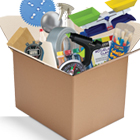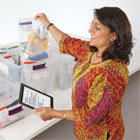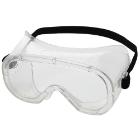Rad Labs at Home: 10 tips for setting up a home-science lab for students
Real-world scientists know that discovery doesn't just happen in the lab or classroom – it can happen anywhere. A science lab is any space that safely enables students to question, test, analyze, and explore. Although many science labs used in professional, educational, and clinical settings have fancy equipment and the latest technology, when it comes to learning from home, all your students need to create a dedicated space for science discovery are a few simple materials and a curiosity to explore.
If you're looking for guidance to help your students create a safe and functional lab space for hands-on science exploration at home, these ten tips will help get you started:
- First things first. Ensure students get parental permission and support. They should ask an adult for help finding a suitable spot for the lab. Ideally, a place near a sink; if they're doing it right, then they're sure to get messy!
- Prepare a space and make good use of the whatever space they have! Students can set up a small desk, chairs, table, and a bookshelf to keep their lab organized. If possible, they should choose a space near a window to get the best lighting-- this can even be a corner of the kitchen table or countertop.
- Ensure there is proper ventilation and an easy exit from the lab. Remind students to open a window or turn on a kitchen exhaust fan.
- Plan out your science activities. Start with some learn-at-home activities spotlighted by Ward's World or use boxed kits like those recommended below. Identify age-appropriate activities.
- Gather the science supplies. Lab equipment and chemicals can be sourced from a scientific supply company like Ward's Science. Still, students can conduct many experiments and projects using everyday household items, like measuring spoons, coffee filters, glass jars, string, pencils, food coloring, baking soda and powder, salt, sugar, vinegar, ammonia, etc. The ideas shared in makerspace guides can be useful resources; Makerspace 101 and How to build a makerspace on a budget are great places to start.
- Use a laboratory notebook. Keeping consistent and accurate lab notes is a great way to help students organize and keep track of their learning experience.
- Keep clean up and safety in mind. Students should keep a trash can, broom, dustpan, sponge, soap, and clean-up cloths on hand. Make sure they have access to clean water. Reinforce the importance of adhering to a robust safety protocol. The at-home lab should be stocked with personal protective equipment such as goggles and gloves.
- Clearly define the boundaries of the laboratory. Ask students to identify the walls and floor space that separate the lab from other areas of the home.
- While conducting experiments in a lab is loads of fun, it's not for playing or eating. Always keep food and drinks away from the lab. Lab time feeds the mind, not the tummy.
- Don't forget to consider whether other children may interact with the lab. If there will be more than one child involved, ensure there are enough supplies and materials of one activity to accommodate all students involved. If students of different age/grade levels will be participating, explain how to modify activities to make them age-appropriate.
Students will enjoy making models and doing experiments with materials available at home. These labs are perfect for distance learners or future scientists in your class who just can't get enough.
Most important of all, have fun! Don't be afraid to get imaginative—that's how the best discoveries are made.
Recommended products
[StartProductBlock]

Ward's Quick Kits
Build your own science kit for delivery in as little as four weeks. A fast way to get made-to-order science kits using the items you need.
[EndProductBlock]
[StartProductBlock]

Ward's Custom Kits
Ward's Science will source, organize, label, package, and ship your materials, your way so you or your students can easily purchase all required lab materials in one convenient kit.
[EndProductBlock]
[StartProductBlock]

Distance Learning Resources
A comprehensive list of essential materials and resources, including extended access to educational software and applications, free downloads and online resources for at-home learning, and hands-on science kits and materials that are easy to distribute to students for learning at home.
[EndProductBlock]
[StartProductBlock]
Nitrile Glove Student Packs
Smaller number of gloves, perfect for individual student use. Ten pairs of gloves per pack. Excellent sensitivity and dexterity. Powder-free nitrile exam gloves contain no natural rubber proteins and are 100% latex-free.
[EndProductBlock]
[StartProductBlock]

Goggles
A range of safety goggles to protect students in the lab.
[EndProductBlock]
